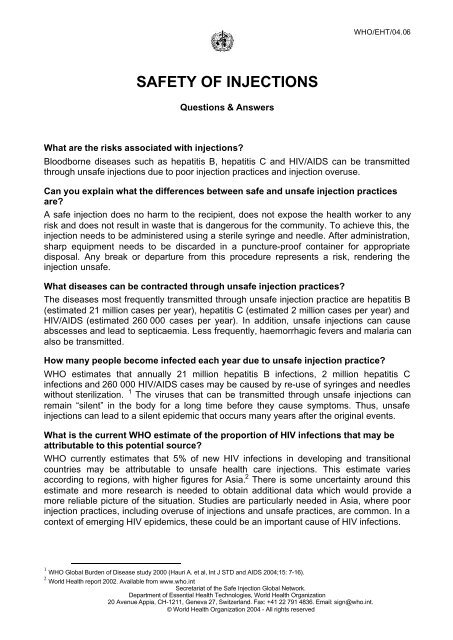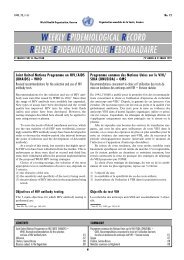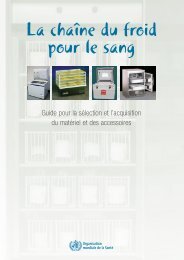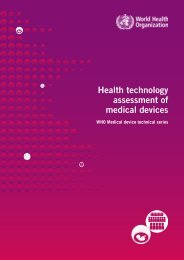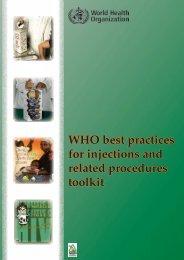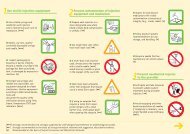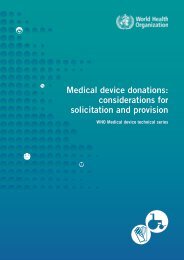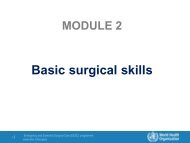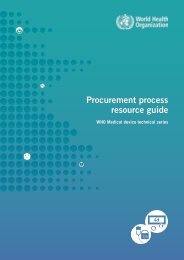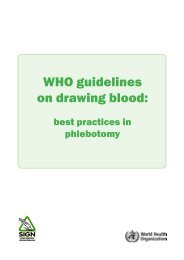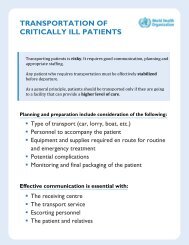SAFETY OF INJECTIONS - World Health Organization
SAFETY OF INJECTIONS - World Health Organization
SAFETY OF INJECTIONS - World Health Organization
You also want an ePaper? Increase the reach of your titles
YUMPU automatically turns print PDFs into web optimized ePapers that Google loves.
WHO/EHT/04.06<strong>SAFETY</strong> <strong>OF</strong> <strong>INJECTIONS</strong>Questions & AnswersWhat are the risks associated with injections?Bloodborne diseases such as hepatitis B, hepatitis C and HIV/AIDS can be transmittedthrough unsafe injections due to poor injection practices and injection overuse.Can you explain what the differences between safe and unsafe injection practicesare?A safe injection does no harm to the recipient, does not expose the health worker to anyrisk and does not result in waste that is dangerous for the community. To achieve this, theinjection needs to be administered using a sterile syringe and needle. After administration,sharp equipment needs to be discarded in a puncture-proof container for appropriatedisposal. Any break or departure from this procedure represents a risk, rendering theinjection unsafe.What diseases can be contracted through unsafe injection practices?The diseases most frequently transmitted through unsafe injection practice are hepatitis B(estimated 21 million cases per year), hepatitis C (estimated 2 million cases per year) andHIV/AIDS (estimated 260 000 cases per year). In addition, unsafe injections can causeabscesses and lead to septicaemia. Less frequently, haemorrhagic fevers and malaria canalso be transmitted.How many people become infected each year due to unsafe injection practice?WHO estimates that annually 21 million hepatitis B infections, 2 million hepatitis Cinfections and 260 000 HIV/AIDS cases may be caused by re-use of syringes and needleswithout sterilization. 1 The viruses that can be transmitted through unsafe injections canremain “silent” in the body for a long time before they cause symptoms. Thus, unsafeinjections can lead to a silent epidemic that occurs many years after the original events.What is the current WHO estimate of the proportion of HIV infections that may beattributable to this potential source?WHO currently estimates that 5% of new HIV infections in developing and transitionalcountries may be attributable to unsafe health care injections. This estimate variesaccording to regions, with higher figures for Asia. 2 There is some uncertainty around thisestimate and more research is needed to obtain additional data which would provide amore reliable picture of the situation. Studies are particularly needed in Asia, where poorinjection practices, including overuse of injections and unsafe practices, are common. In acontext of emerging HIV epidemics, these could be an important cause of HIV infections.1 WHO Global Burden of Disease study 2000 (Hauri A. et al, Int J STD and AIDS 2004;15: 7-16).2 <strong>World</strong> <strong>Health</strong> report 2002. Available from www.who.intSecretariat of the Safe Injection Global Network.Department of Essential <strong>Health</strong> Technologies, <strong>World</strong> <strong>Health</strong> <strong>Organization</strong>20 Avenue Appia, CH-1211, Geneva 27, Switzerland. Fax: +41 22 791 4836. Email: sign@who.int.© <strong>World</strong> <strong>Health</strong> <strong>Organization</strong> 2004 - All rights reserved
How many injections are administered annually worldwide?About 16 billion preventive and curative injections are given each year in developing andtransitional countries. Over 95% of all injections given are curative (therapeutic): for everyvaccination given, 20 therapeutic injections are administered.How does overuse of injections lead to the transmission of bloodborne pathogens?The more injections are given, the more people are exposed to needles and syringes. Inaddition, if the use of injections exceeds the availability of injection equipment allows, reuseof syringes and needles is likely to occur. Therefore the greater the use, the higher therisk.What are the reasons for injection overuse?Patients and health care workers often believe that injections are more effective and actfaster than oral medication. In addition, health care workers can charge an increased feefor injections.Are health care workers not aware of the risks of unsafe injection practices?In many cases trained health care workers such as physicians, nurses and paramedicalstaff have not been trained in safe injection practices. Often, they lack the awareness ofthe risks associated with unsafe practices. In addition, in some communities, untrained laypersons administer injections outside the formal health care sector.Is it difficult to make injections safe?The strategies to make injections safe are straightforward. They include communitybehaviour change induced through communication activities in a supportive environment.Adequate injection equipment must be provided in sufficient quantities and a reliable wastedisposal infrastructure must be made available. Many success stories suggest that this isan achievable goal.Why are syringes re-used in the developing world?Widespread re-use of syringes and needles in the developing world is due to severalfactors:• a lack of awareness regarding the risks associated with syringe re-use• cultural resistance to waste in countries where resources are scarce;• a lack of supplies of syringes and needles;• the absence of infrastructure for the safe collection and destruction of used injectionequipment, allowing for scavenging and parallel market development.What constitutes safe syringe disposal?Safe syringe disposal requires that syringes and needles be placed in puncture-proofcontainers (safety box) immediately after use. These boxes must then be collected forincineration or other forms of destruction.What is the cost of unsafe injections?First, unnecessary injections waste precious health care resources. Second, theconsequences of unsafe injections lead to death and disability. In 2000, WHO estimatesthat 501 000 deaths occurred because of unsafe injection in the past. In addition, unsafeinjections in 2000 will lead to 9 million years of life lost (adjusted for disability) between2000 and 2030.2
What are the WHO recommendations for a safe and appropriate use of injections?Four key interventions would ensure the safe and appropriate use of injections:1. Increasing the awareness of the population regarding the risk of HIV and otherinfections associated with unsafe and unnecessary injections.2. Building the safe and appropriate use of injections within National Essential MedicinePolicies to make sure there are sufficient quantities of single-use injection devices andsafety boxes in every health care facility and to make sure that unnecessary injectionsare avoided.3. Ensuring that all donors and lenders who support the supply of injectable substances indeveloping and transitional countries also support the provision of injection deviceswith reuse-prevention features and safety boxes4. Managing the waste associated with dirty syringes and needles in a safe andappropriate way.Is injection safety a cost-effective intervention?The safe and appropriate use of injections is a sound investment in health. WHO hasestimated that interventions implemented in 2000 for the safe and appropriate use ofinjections would have cost $102 per year of life saved (adjusted for disability). 3 This cost isunder the threshold of one year of average per capita income used by the WHOCommission on Macroeconomics and <strong>Health</strong> as a criterion for an intervention to beconsidered very cost-effective.Should HIV prevention and care programmes place a stronger emphasis on the safeand appropriate use of injections?Implementation of safe and appropriate use of injections as part of HIV prevention andcare programmes is highly desirable and can be accomplished with only a modest shift inthe assignment of resources for two reasons:(1) Injection safety is not a costly intervention;(2) The large majority of HIV infections worldwide are caused by unsafe sexual practices,thus the emphasis of HIV prevention programmes must remain on preventing sexualtransmission.3 WHO CHOICE project, <strong>World</strong> <strong>Health</strong> Report 2002.3


